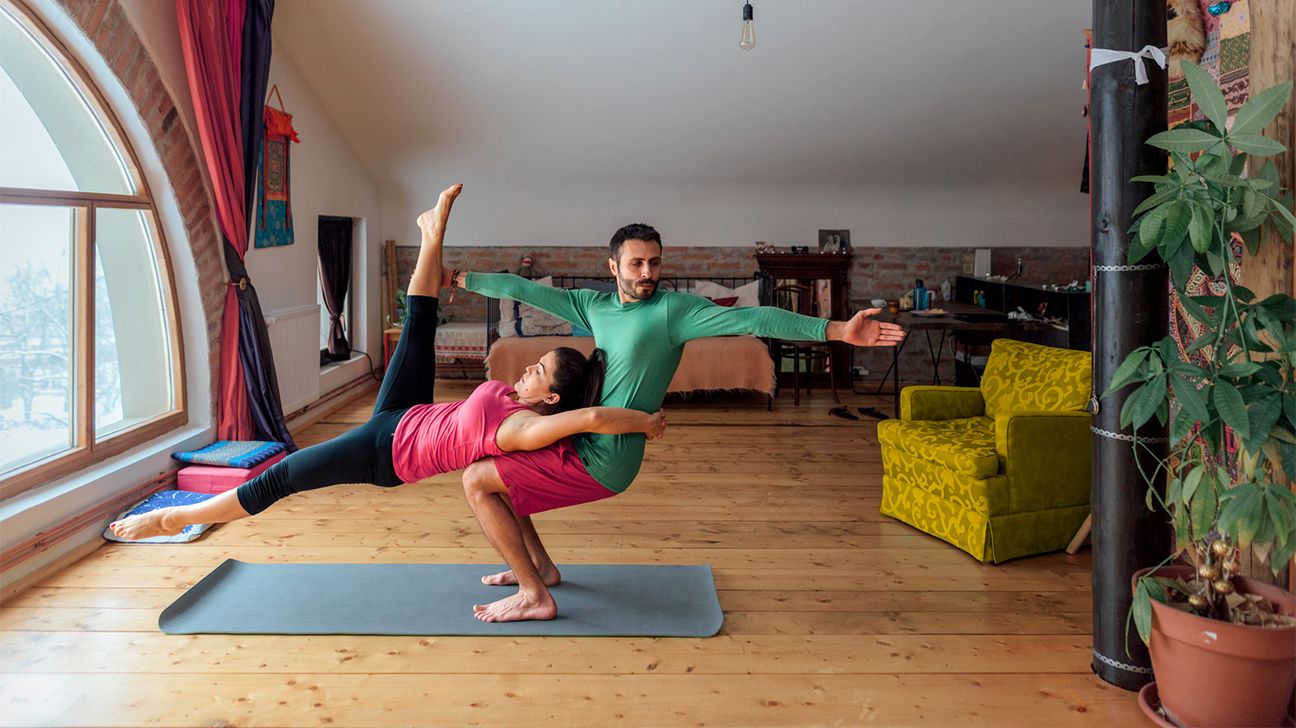There’s a reason why AcroYoga is taking over TikTok. This bomb blend of yoga and acrobatics is an exciting challenge for your mind and body. But before you hop on this trend train, there are some things you need to know.
Here’s a deep dive into all things AcroYoga, including the best poses for beginners and safety tips for all.

AcroYoga is a physical practice that combines the principles of yoga and acrobatics. It also draws inspo from cheerleading, dance acro, and circus arts. While you can technically do it solo, AcroYoga is usually performed with a partner or in a group.
The three primary roles in AcroYoga are:
- Base. This person has the most contact with the ground. They usually support the flyer with their feet and hands. Bases tend to have their back or belly on the floor, but they can also be in a standing position.
- Flyer. These folks are elevated off the ground by the base. This position requires a lot of core strength and balance.
- Spotter. Spotters are peeps who protect the flyer from falling. They also make sure the flyer lands correctly and might give recommendations to improve their form.
TBH, there’s not a whole lot of research to back the benefits of AcroYoga specifically. But we do have plenty of deets to prove the perks of yogi life. Here’s the lowdown.
- Increases strength. AcroYoga is a dope dynamic exercise. Your body goes through a full range of motion and different points of balance. This makes it a great way to increase muscle strength.
- Builds balance. A 2015 research review showed that yoga-based exercises may help improve balance and increase mobility.
- Calms the mind. Yoga could be a great way to reduce anxiety and relieve stress.
- Boosts confidence. Some studies suggest a regular yoga practice can increase confidence and feelings of self-worth. Since AcroYoga requires a lot of determination, it may help you tap into your inner-strength in a big way.
- Improves concentration. Studies show yoga might help improve concentration and improve your ability to think.
Are you ready to give AcroYoga a whirl? Here are the best beginner poses to practice.
Beginner: Fish on a Leaf
This pose will help you take it slow to start. No one has to go airborne, but you’ll each get a deep back stretch.
Here’s how to do it
- Base begins by sitting on their knees, hinging forward at the hips, and extending arms out to rest on the floor in front of them. (They’ll be in Child’s Pose.)
- Flyer lies faceup on base’s back.
- Flyer may extend legs and arms, or completely relax.
Moderate: Plank Press
This pose can help the base learn how to balance and support the weight of a flyer.
Here’s how to do it
- Base begins by lying on their back with knees bent and feet flat on the ground.
- Flyer begins by standing at base’s feet, facing them.
- Base places feet on the front of flyer’s hips, then brings knees toward chest.
- Flyer activates core to stabilize the body in a straight line, hands at the sides.
- Base continues to bring knees to chest until base is ready to support and balance flyer’s weight.
- If possible, base straightens legs and lifts flyer off the ground until their torsos are parallel. Holding hands can help with balance, if needed.
Advanced: Jedi Plank
Get your Yoda yoga on with this core-strengthening pose for both partners.
Here’s how to do it
- Base begins by lying on the floor on their back, legs outstretched.
- Flyer stands facing base’s feet.
- Flyer grips base’s ankles and brings the legs one at a time over base.
- Base straightens arms to grip flyer’s ankles. (Flyer will be in a Plank Pose, supported entirely by base.)
- As an option, both base and flyer can hinge at hips, keeping legs and arms straight.
Finding a studio
You might be able to find an AcroYoga class at your local yoga studio or gym. But if you can’t find any IRL classes — or if they’re just not your thing — don’t worry. AcroYoga International has some fab online resources like live and online sessions. You can also opt for an app like:
Overall, AcroYoga can be an amazing activity for lots of folks. But it can be a bit intimidating, especially if you’re a yoga newbie. Here are some tips to help you keep your practice fun and safe:
- Warm up. Whether you’re an absolute beginner or a seasoned yogi, you should never skip a warm-up before attempting challenging poses. This can help prevent injury.
- Take your time. AcroYoga can be hella hard. So, be patient with the process and don’t push yourself past your limits. Start slow with easier forms and work your way up over time.
- Communication is key. Unlike other forms of yoga, AcroYoga requires communication. You need to discuss your intention before each pose with your partner(s).
- Pick the right partner. You might be tempted to leap into a High Flying Whale Pose with your pals. But AcroYoga poses require a lot of concentration and trust. Only practice with a partner that takes safety seriously.
PSA: You should avoid AcroYoga if you’re preggo or recovering from an injury. Also, you should talk with your doctor before doing AcroYoga if you have high blood pressure or vertigo.
AcroYoga boasts the best of both worlds. It’s a fun combo of yoga and acrobatics. Just keep in mind, it requires a lot of core strength, balance, and determination. But even though it’s tough, it’s still safe for most folks to do.
You might be able to sign up for an AcroYoga class at your local yoga studio or gym. You can also check out online courses or download an AcroYoga app.

